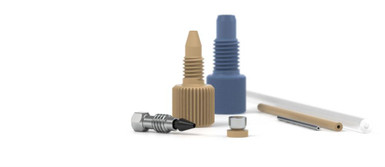Posted by Chrom Tech on 15th Oct 2025
What Types of Fittings Are Used in HPLC?
In any HPLC system, reliable connections are essential to prevent leaks, maintain pressure stability, and ensure accurate chromatographic performance. There are two main categories of HPLC fittings: low-pressure fittings and high-pressure fittings. Each serves a specific purpose along the flow path—from the solvent reservoir to the waste system—and selecting the correct fitting type can make the difference between smooth operation and frustrating downtime.
Low-Pressure vs. High-Pressure Fittings
Low-pressure fittings are used from the solvent reservoir to the pump inlet and again after the detector to the waste system. High-pressure fittings, on the other hand, connect components along the high-pressure flow path—from the pump outlet through the column and detector.
Although fittings are a relatively inexpensive part of your HPLC setup, their quality and installation accuracy are critical. Poorly fitted or incompatible connections can cause leaks, erratic flow, or even damage to the system. Experienced chromatographers know that reliable, properly installed fittings are key to maintaining peak performance and consistent results.
Flangeless Fittings: The Most Common Low-Pressure Connection
One of the most common low-pressure fittings used in modern HPLC systems is the ¼-28 flat-bottom flangeless fitting. Found in the solvent line between the reservoir bottle and the pump inlet, these fittings are favored for their convenience and reusability.
Before flangeless fittings became standard, tubing had to be manually flanged using specialized tools—a tedious and time-consuming process. Flangeless designs eliminate that step entirely. To install, simply slip the nut and ferrule over the tubing and finger-tighten it into the port. No flanging tools are required, and component replacement takes seconds.
Advantages of flangeless fittings include:
- Quick, tool-free installation
- Reusable design with minimal maintenance
- Minimal downtime—only the ferrule typically needs replacing
- Excellent sealing performance for low-pressure flow paths
Other Common Low-Pressure Fittings
Other fitting types are also used for low-pressure applications, especially in priming, drainage, and waste systems.
Luer Adapters
Luer fittings provide simple connections between threaded ports and disposable syringes. For example, when priming an HPLC pump, you can remove the outlet check valve’s 10-32 fitting and insert a P-642 Female Luer to 10-32 Male Adapter. This allows a disposable luer syringe to draw mobile phase through the pump head quickly and safely.
Barbed Adapters
Barbed fittings are typically used to connect flexible tubing to threaded ports—most often between the detector outlet and the waste container. If your lab requires a closed waste collection setup to comply with safety regulations, consider Chrom Tech’s Solvent Waste Container Kit. This system helps ensure safe disposal while keeping your lab in compliance with environmental and workplace safety standards.
High-Pressure Fittings: 10-32 Coned Connections
High-pressure fittings are used from the pump outlet through the column and detector. The most common connection type is the 10-32 coned fitting, available in both stainless steel and polymeric materials. These fittings are designed to maintain a tight seal under extreme pressures found in HPLC and UHPLC systems.
Wrench-Tightened Stainless Steel Fittings
Stainless steel fittings are the standard for high-pressure applications and are tightened using a wrench to create a secure, leak-free seal. These fittings rely on a swaged ferrule connection—a process that permanently crimps the ferrule onto the tubing.
To make a proper swaged connection:
- Slide the nut over the tubing, followed by the ferrule (with the tapered end facing away from the nut).
- Insert the tubing into the port until it seats firmly against the bottom stop.
- Finger-tighten the nut, then wrench-tighten another ¾ turn to form the swage.
- Disassemble and inspect to ensure the ferrule is fixed securely to the tubing.
Swaged connections can withstand pressures exceeding 4,000 psi for HPLC and up to 15,000 psi (1,034 bar) for UHPLC applications. While durable, they require careful installation—ideally with a helping hand!
Fingertight Fittings
For greater convenience, fingertight fittings were introduced as a tool-free alternative. These polymer or hybrid fittings can achieve reliable seals up to 4,000 psi, with some newer models rated as high as 18,850 psi (1,300 bar). Fingertight designs are especially popular for routine maintenance and quick reconfiguration of systems.
Conclusion
Understanding which fittings to use—and how to properly install them—is essential to maintaining a leak-free, stable HPLC system. Low-pressure fittings like flangeless and luer adapters simplify setup and maintenance, while high-pressure 10-32 coned fittings ensure robust connections in critical flow paths.
With today’s improved designs, fitting installation is faster, safer, and more reliable than ever before. If you’re unsure which fittings best suit your application, reach out to Chrom Tech’s technical experts at support@chromtech.com. We offer a full selection of HPLC fittings and accessories for any configuration.
Frequently Asked Questions About HPLC Fittings
What are the two main types of HPLC fittings?
HPLC systems use low-pressure fittings from the solvent reservoir to the pump inlet and again after the detector to the waste system, and high-pressure fittings between the pump outlet, column, and detector.
What are flangeless fittings used for?
Flangeless fittings connect low-pressure tubing without the need for specialized flanging tools. They are reusable, quick to install, and most commonly used between the solvent reservoir and the HPLC pump inlet.
What pressure ratings can HPLC fittings withstand?
Typical HPLC systems operate around 4,000 psi (276 bar), while UHPLC systems can reach up to 15,000 psi (1,034 bar). High-quality stainless steel or advanced polymer fingertight fittings can accommodate these pressures when properly installed.

